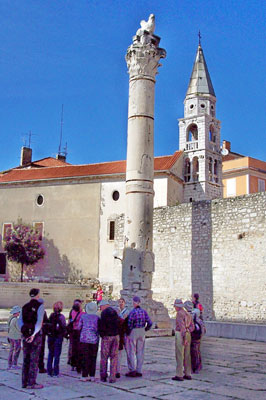Adriatic Adventure: Croatia in depth
This item appears on page 62 of the October 2012 issue.
(Second of three parts)
The alluring coastal region of Croatia was the focus of the second segment of the “Adriatic Adventure” I took with ElderTreks in April-May 2012. Over days 7 to 13, our group traversed the area from Split, in the south, northward to the Slovenian border.
This part of our Croatian journey combined discovering a wealth of ancient architectural and cultural treasures with exploring the mostly undeveloped, pristine, azure coastline. It was further enhanced by the sight of inviting mountain vistas, serene lakes, raging rivers and glorious waterfalls.
Nonstop exploring
Returning to Croatia from Bosnia & Herzegovina, our group first stopped to see the “Red Lake” and “Blue Lake,” two enormous sinkholes near Imotski. These rarely visited karst lakes are believed to be the remains of huge caves whose roofs have collapsed.
Upon arriving in Split, the largest city on Croatia’s Adriatic coast, we toured the huge Diocletian Palace, constructed as a retirement retreat/fortress by the fourth-century Roman emperor Diocletian. In this part of the city’s Old Town, wandering the narrow streets and alleys is akin to visiting an open-air, living museum.
Our base for two nights was Skradin, a tiny, quaint village located on a quiet inland waterway. In my free time, I hiked to the remains of an ancient hilltop fortress that afforded sweeping views over the town and waterways.
While in the area, we visited a lost-in-time Franciscan monastery, a one-hour boat ride up the serene, clear Krka River, before undertaking a 2-hour hike in Krka National Park. There we found scores of small waterfalls and no shortage of other international visitors.
Ancient coastal treasures
Our exploration of Croatia continued the following day with a visit to seaside Šibenik, where we enjoyed a guided walking tour of the compact Old Town, whose attractions include the Gothic-Renaissance St. Jacob’s Cathedral, on the UNESCO World Heritage List. We also climbed to the hilltop 13th-century citadel, which affords sweeping views over the city and coastal surrounds.
In the afternoon we explored one of my favorite Croatian cities, Zadar, where our extensive guided walking tour served up a cornucopia of ancient and modern sights. The historic attractions included ancient churches in various states of preservation, monasteries, palaces and even the original Venetian city wall.
On the visitor-friendly waterfront, I particularly enjoyed the haunting bellows of a unique sea organ, whose sound is driven by wave action, and the “Sun Salutation,” a colorful installation of decorative solar panels that visitors can walk on.
In Starigrad Paklenica, we were accommodated for two nights in a seafront hotel near the entrance to Paklenica National Park. Our first evening, a stroll along the quiet beach to a neighboring campground rewarded me with one of the most inspiring sunsets of my travels.
Scaling the heights and more
Gorge climbing was on tap the next morning, as our strenuous 3-hour hike in Paklenica National Park proved to be among the most testing walks of our 3-week journey.
We often were dwarfed by steep canyon walls — an obvious beckon to rock climbers, including those whom we observed testing their skills. The strikingly beautiful twin gorges feature stands of Austrian fir, ancient beech forests and a broad range of bird species and reptiles. Paklenica is considered to be one of the finest parks in the entire Adriatic region.
The following day, our routing continued north and inland to Plitvice Lakes National Park, which features scores of picture-perfect waterfalls accessed by fine hiking trails. Our hike made it clear why Plitvice is so popular with international visitors and is so deserving of its UNESCO World Heritage status.
Later we enjoyed a picnic lunch on the banks of the idyllic Otocˇac River, known for its spectacular fly-fishing. I would have happily traded my shoes for a few hours of free time with rod and reel in hand.
Opatija riviera beckons
In late afternoon we traveled back to the coast and the popular Opatija riviera, located on the Istrian Peninsula, settling into our waterfront accommodation in entrancing Lovran for two nights.
This alluring coastal region of northern Croatia has a decidedly Italian feel and flavor. Lovran certainly won my heart with its inviting seafront walkways, coves, marinas and outdoor restaurants. The lively nightlife scene along the waterfront was thoroughly inviting. Thankfully, one afternoon I had time to join a few locals for a swim in the brisk, clear sea.
On our first morning based in Lovran we took a ferry to sparsely developed Cres Island, the second largest of the Adriatic islands. Upon disembarking, we toured a sanctuary for endangered griffon vultures, then hiked in a forest reserve featuring century-old oaks and chestnut trees.
Istrian Peninsula trio
Myriad Istrian Peninsula treasures were revealed on our final full day in Croatia during visits to three historic seafront towns.
Our walking tour in lively, popular Pula included its spectacular first-century Roman amphitheater, a “must visit,” and the Temple of Augustus.
In the ancient city of Poreč, certainly deserving of its UNESCO World Heritage status, our touring included a sixth-century-BC basilica featuring gold mosaics.
Charming Rovinj, with its sixth-century St. Euphemia Church, is a small, relaxing waterfront town that is highly recommended as a relatively undiscovered European hideaway by ITN’s own Rick Steves.
During our return to Lovran, we encountered the longest of the many very impressive highway tunnels that we burrowed through in Croatia.
In part three of my Adriatic exploration, I will report on Trieste and Venice, Italy, and on Slovenia.
My trip was partially hosted by Eldertreks (Toronto, Ont.; 800/741-7956). Contact them for information concerning Adriatic touring and a wide range of adventure-oriented small-group tours.
Keck's Beyond the Garden Wall
❝The heights plunge to the blue beyond
Symbiotic naturescape extraordinaire❞
— Randy’s experience of the visual feast proffered by coastal Croatia


